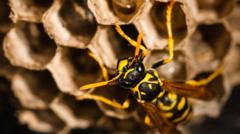The discovery of a radioactive wasp nest at the Savannah River Site (SRS) in South Carolina has sparked interest and concern. Federal officials reported that the nest contained radiation levels ten times higher than the allowed regulations. The nest was promptly sprayed to eliminate the wasps and was subsequently bagged as radiological waste. Fortunately, no wasps were present at the site during the inspection conducted on July 3.
Investigators clarified that this radiation isn't due to a nuclear waste leak and has not impacted the environment or public health. The contamination is attributed to "onsite legacy radioactive contamination," which is the leftover radioactivity from the site's Cold War-era operations when it produced nuclear weapon parts.
Though the SRS remains operational, its current focus is on nuclear material for power generation. The US Department of Energy emphasized that the wasps, which typically stay close to their nests, likely did not disperse into surrounding areas. However, watchdog groups like Savannah River Site Watch expressed frustration, calling for transparency about the source of the radioactive contamination and any potential leaks.
As the site holds approximately 43 underground tanks of nuclear waste, questions linger regarding the safety protocols at this facility that once managed over 165 million gallons of nuclear waste.
Investigators clarified that this radiation isn't due to a nuclear waste leak and has not impacted the environment or public health. The contamination is attributed to "onsite legacy radioactive contamination," which is the leftover radioactivity from the site's Cold War-era operations when it produced nuclear weapon parts.
Though the SRS remains operational, its current focus is on nuclear material for power generation. The US Department of Energy emphasized that the wasps, which typically stay close to their nests, likely did not disperse into surrounding areas. However, watchdog groups like Savannah River Site Watch expressed frustration, calling for transparency about the source of the radioactive contamination and any potential leaks.
As the site holds approximately 43 underground tanks of nuclear waste, questions linger regarding the safety protocols at this facility that once managed over 165 million gallons of nuclear waste.


















